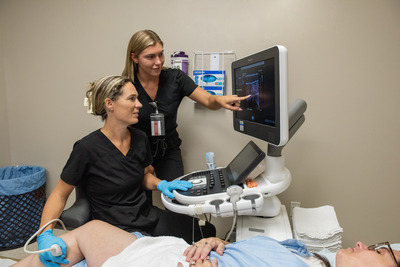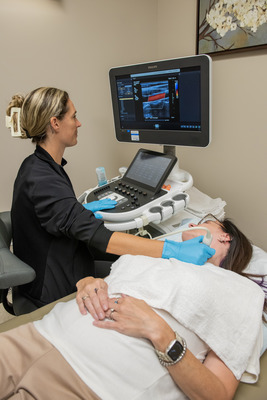 To provide the best possible patient care, our Vascular Surgery Service uses the Non-Invasive Vascular Laboratory of Stony Brook University Hospital. The Non-Invasive Vascular Laboratory at Stony Brook Medicine performs sophisticated non-invasive cerebral, peripheral, and abdominal vascular studies. Our lab is fully accredited by the Intersocietal Accreditation Commission (IAC). Meeting the high standards set by the ICA demonstrates our lab's commitment to excellence and quality assurance in vascular testing.
To provide the best possible patient care, our Vascular Surgery Service uses the Non-Invasive Vascular Laboratory of Stony Brook University Hospital. The Non-Invasive Vascular Laboratory at Stony Brook Medicine performs sophisticated non-invasive cerebral, peripheral, and abdominal vascular studies. Our lab is fully accredited by the Intersocietal Accreditation Commission (IAC). Meeting the high standards set by the ICA demonstrates our lab's commitment to excellence and quality assurance in vascular testing.
The lab houses a wide variety of state-of-the-art equipment used not only as aids in the diagnosis of circulatory disorders, but also in the follow-up of a large number of outpatients. Our Non-Invasive Vascular Laboratory is complemented by an excellent special procedures division of the radiology department.
The special procedures division provides service in all the techniques of interventional radiology, including balloon dilatation (angioplasty), invasive pressure monitoring, and therapeutic embolization.
| Director: Nicos Labropoulos, PhD, RVT |
| Co-Medical Director: Angela A. Kokkosis, MD |
| RVT Hospital Manager: Toniann Barresi |
*All appointments for testing require a written order from a physician
| Stony Brook University Hospital | Stony Brook Vascular Center |
| To schedule an appointment call, (631) 444-1716 | To schedule an appointment call, (631) 638-1670 |
| Non-Invasive Vascular Laboratory Stony Brook University Hospital 100 Nicolls Road Stony Brook, NY 11794 8th Floor, Rm 100 (L8-South) | Stony Brook Vascular Center 23 South Howell Avenue, Suite G Centereach, NY 11720 |
 Non-invasive vascular evaluations offer a number of advantages. These sophisticated tests are painless and can document the presence, location, and severity of arterial and venous vascular disease. In addition, the non-invasive nature of the exam greatly reduces patient risk and enhances patient comfort when compared to invasive diagnostic procedures. These tests are also cost-effective, an important consideration in today's healthcare environment.
Non-invasive vascular evaluations offer a number of advantages. These sophisticated tests are painless and can document the presence, location, and severity of arterial and venous vascular disease. In addition, the non-invasive nature of the exam greatly reduces patient risk and enhances patient comfort when compared to invasive diagnostic procedures. These tests are also cost-effective, an important consideration in today's healthcare environment.
The Non-Invasive Vascular Laboratory takes a "service-oriented" approach to physicians and patients. This is exemplified by:
- Rapid Report Turn-Around Time
- Sensitivity to Patient Needs
- Comprehensive Evaluation
- State-of-the-Art Technology- including Direct Studies & Indirect Studies
Indirect Studies
Indirect studies also play a key role in non-invasive vascular evaluations. These tests include digital plethysmographic analysis for evaluation of perfusion, spectral waveform analysis for characterization of the Doppler velocity signals and segmental Doppler systolic pressures. The Non-Invasive Vascular Laboratory performs the following procedures:
- Peripheral Arterial, Peripheral Venous, Abdominal Vessels and Cerebrovascular
Listed below are clinical conditions that indicate the need for non-invasive vascular studies:
Cerebrovascular
- Amaurosis fugax
- Atypical central nervous system symptoms
- Carotid bruit
- Follow-up of carotid stenosis
- Non-hemispheric cerebral ischemic symptoms
- Post-surgical evaluation for carotid restenosis
- Prior to heart or major surgeries in selected cases
- Question of carotid dissection
- Question of carotid aneurysm
- Stroke
- Subclavian steal
- TIA (transischemic attack)
- Vague symptoms of light-headedness, dizziness or syncope
- Vertebral basilar symptoms
- Vertebral occlusive disease
Abdominal Vessels
- Abdominal aortic aneurysm
- Abdominal bruit
- Aortoiliac occlusive disease
- Follow-up of aortic, renal, mesenteric or iliac stenosis
- Follow-up of renal or iliac angioplasty/stent procedures
- Iliac vein or caval thrombosis
- Ischemic nephropathy
- Mesenteric ischemia
- Post-surgical evaluation of aortic, renal or mesenteric grafts
- Post-surgical evaluation of aortic, renal, mesenteric or iliac stenosis
- Renovascular hypertension
Peripheral Venous
- Chronic venous insufficiency, reflux/valvular incompetence
- Follow-up during and after anti-coagulant therapy
- Observation of high-risk patient groups for development of deep venous thrombosis (e.g., pregnant females, cancer patients)
- Suspected deep venous thrombosis or superficial phlebitis
- Varicose veins
- Vein mapping for coronary or peripheral arterial reconstruction
- Venous evaluation prior to implantation of various access devices (e.g., catheters, lines)
Peripheral Arterial
- Bypass graft follow-up
- Diminished or absent peripheral pulses
- Evaluation of degree of claudication, if present
- Evaluation of medical management
- Leg pain of questionable etiology
- Non-healing foot/toe lesions
- Peripheral aneurysm evaluation
- Rest pain (diabetic neuropathy versus ischemia)
- Trauma to peripheral artery
- Vasospastic disorders

